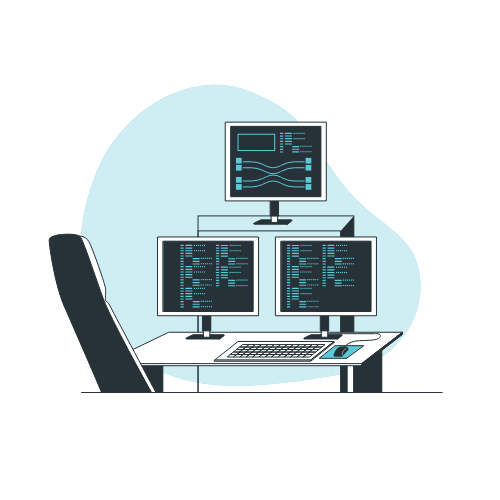As we continue to advance in the digital world, the software development industry is undergoing significant changes. By 2024, software development companies will play a vital role in the evolving landscape as they utilize the latest technologies and various software development methodologies to create, design, and maintain customized software solutions for specific business requirements. For businesses and developers, it’s not only about keeping pace; it’s about forging ahead and succeeding in a competitive digital environment.
This article covers the top software development trends of 2024 and how they can power your next mobile application development project and business.
What’s Driving Software Development?
Before delving into the software development trends, let’s first examine the forces that are driving the software development industry. These forces are not only reshaping web development companies and the way software is built but also how businesses function and engage with their customers in the digital realm.
Technologies
Emerging technologies are moving at a rapid pace to the best software development companies and are the biggest drivers of change in software development trends. Here are some to watch:
Artificial Intelligence and Machine Learning Integration
AI and ML are no longer just buzzwords; they are becoming core components of modern software. From predictive analytics to natural language processing, AI-powered features are improving user experiences and automating complex tasks across industries.
There is a huge demand for AI integration in many custom software solutions and projects. For example, AI-driven inventory management systems for retail clients have been known to reduce overstocking by 22% and improve sales forecasting by 35%.
Internet of Things (IoT) and Edge Computing
The rise of IoT devices is creating vast amounts of data, presenting new challenges and opportunities for software engineers and developers. Edge computing, which involves processing data closer to its source, is emerging as a solution to handle this data influx.
Integrating edge computing principles into IoT projects, particularly for manufacturing and smart city initiatives, has notably enhanced real-time data processing and reduced latency in critical applications.
Blockchain and Cybersecurity
With the rise of digital transactions, ensuring security is more crucial than ever. Blockchain technology is now being utilized in various applications beyond cryptocurrency to guarantee data integrity and secure transactions.
Industries are adopting blockchain for supply chain management and digital identity verification, enhancing security and transparency in their operations.
Cloud-Native Applications and Serverless Architecture
The shift to cloud-native and serverless technologies is transforming the way applications are developed, deployed, and expanded. These methods offer increased flexibility, reduced operational burden, and improved resource efficiency.
Numerous companies have experienced significant cost savings and improved scalability following the transition to a cloud-native infrastructure. For instance, a fintech startup witnessed a 40% decrease in infrastructure expenses after adopting a serverless architecture.
Quantum Computing
Quantum computing is still in its early stages but has the potential to revolutionize complex problem-solving in fields such as cryptography, drug discovery, software engineering, and financial modeling. Forward-thinking companies are already investigating how quantum computing will affect their industry in the coming years.
Software Development Trends 2024

Now let’s get into the software development trends that are shaping software development in 2024:
Cloud-Native Applications
Cloud-native applications have taken off, and for good reason. Cloud-native app development brings:
- Scalability and flexibility
- Resilience and fault tolerance
- Faster time to market for new features and updates
- Cost-effective resource utilization
Many organizations have fully embraced cloud-native practices by utilizing containerization technologies such as Docker and orchestration tools like Kubernetes to develop and deploy reliable and scalable applications.
Case Study: A healthcare provider transitioned their patient management system to a cloud-native architecture and experienced a 60% improvement in system responsiveness during peak hours, along with a 30% reduction in overall IT costs.
Cybersecurity in Software Development
With the frequency and complexity of cyber attacks, increasing security can no longer be an afterthought in the software development process. In 2024, we’re seeing a big shift towards “security first” development practices.
- Secure coding practices and secure development lifecycles
- Threat modeling and vulnerability assessments throughout the development process
- Penetration testing and security audits
- Compliance with security regulations and standards (e.g., GDPR, CCPA)
A comprehensive security framework that incorporates these practices throughout the entire software development lifecycle has assisted numerous organizations in preventing security breaches and adhering to industry regulations.
DevOps and Continuous Integration
The DevOps philosophy is gaining momentum, breaking down silos between development and operations teams to deliver software faster and more reliably. Key to this trend are:
- Widespread adoption of Continuous Integration/Continuous Deployment (CI/CD) pipelines
- Increased use of automated testing and quality assurance tools
- IaC (Infrastructure as Code) for managing and provisioning IT infrastructure
- Monitoring and logging for better system observability
DevOps practices have yielded impressive results in development efficiency and software quality. For instance, a B2B SaaS company reduced deployment time from days to hours and experienced a 75% decrease in post-release bugs.
Low-Code and No-Code Platforms
Low-code and no-code platforms are democratizing software and web development, enabling non-technical users to build applications with minimal coding knowledge. This is especially relevant for:
- Rapid prototyping and MVP development
- Giving business users to create custom workflows and automation
- Offloading IT departments for minor application development tasks
While custom, high-performance software solutions are still necessary for complex needs, low-code platforms hold value for specific use cases, and many have successfully combined low-code with custom-developed component development services to deliver full-stack, scalable systems.
Progressive Web Applications (PWAs)
Progressive Web Applications are gaining traction, a middle ground between web, mobile applications, and native mobile apps. PWAs offer:
- Cross-platform compatibility
- Offline functionality
- Better performance and user experience
- Lower development and maintenance costs than native apps
For businesses seeking to expand their mobile app presence, PWAs offer an efficient solution, eliminating the need for separate native apps for various platforms.
Microservices Architecture
The microservices architectural style where an application is composed of loosely coupled services is becoming more popular. This brings:
- Better scalability and flexibility
- Easier maintenance and updates
- Better fault isolation
- Polyglot development (using different programming languages and technologies for different services)
Microservices have been employed in several large enterprise applications, improving development velocity and system reliability.
Artificial Intelligence and Machine Learning Operations (AIOps and MLOps)
As AI and ML become part of software systems, practices are emerging for developing and maintaining these components:
- AIOps: Using AI to augment IT operations and automate mundane tasks
- MLOps: Taking machine learning models to production and maintaining them over time
These practices ensure AI and ML solutions are not just powerful software testing, but also maintainable and scalable in production.
The Role of Custom Software Development Trends

While off-the-shelf solutions have their place, custom software development is still a key part of the digital transformation, helping businesses stand out and solve unique problems. Here’s why custom development is a top choice for many:
Benefits of Custom Software Development
- Custom Solutions: Custom software is built to solve specific business needs and processes, a perfect fit for unique requirements.
- Efficiency: By automating and streamlining specific business processes, custom software can boost operational efficiency by a lot.
- Competitive Advantage: Unique software can give businesses an edge over competitors using generic off-the-shelf products.
- Scalability: Custom software can be designed to grow with your business and adapt to changing needs over time.
- Integration: Custom solutions can be built to integrate with existing systems and workflows.
- Ownership and Control: With custom software, businesses have full control over their technology stack and are not dependent on third-party vendors for critical updates or features.
Choosing the Right Software Development Company
Selecting the right partner for your custom software development services or project is key. Here are the factors to consider:
- Expertise and Technology Stack: Look for a company with experience in your industry and proficiency in the relevant technologies.
- Portfolio and Case Studies: Check the company’s past projects to see what they can do and how they solve problems.
- Client Reviews and Testimonials: Feedback from previous clients can give you an idea of the company’s strengths and working style.
- Communication and Project Management: Good communication and robust project management are essential for a successful collaboration.
- Pricing and Cost Structure: While cost shouldn’t be the only factor, it’s good to understand the pricing model and make sure it fits your budget.
- Cultural Fit: Choose a partner whose values and work culture match yours for a smoother and more productive relationship.
Future of Software Development
Looking beyond 2024, here are the software development trends that will shape the future of software development:
- More AI: AI will be everywhere, with advanced natural language processing and computer vision as standard features in many applications.
- Quantum Computing: As quantum computing matures, we will see new applications in cryptography, complex system modeling, and optimization problems.
- Extended Reality (XR) in Software: Augmented, virtual, and mixed reality will be integrated into mainstream software applications, especially in education, healthcare, and industrial design.
- Ethical AI and Responsible Development: There will be more focus on developing AI systems that are transparent, fair, and accountable with increased regulatory scrutiny.
- Sustainable Software Development: Energy-efficient coding and green computing will become more important as the environmental impact of software systems gets attention.
Getting Started with Software Development
Whether you’re starting a new software project or modernizing existing systems, software developers here are the steps to get started:
- Define Your Goals: Clearly state what you want to achieve with your software project.
- Audit Your Current Systems: Understand your technology stack and identify areas to improve or integrate.
- Research Options: Look at off-the-shelf and custom development to find the best fit for you.
- Choose the Right Partner: Select a software development company that matches your goals, budget, and working style.
- Start Small and Iterate: Consider starting with a minimum viable product (MVP) and iterating based on user feedback and changing requirements.
Summary
2024 will be a great year for software and mobile app development. It’s important to stay updated on these software development trends and collaborate with experienced developers to create powerful, efficient, and user-friendly software. Whether you aim to modernize legacy systems, build new applications, or explore new technologies, understanding these software development trends is crucial for making informed decisions about your software development strategy. When embarking on your next software development project, consider how these software development trends can help you establish a custom software development company that stands out in the digital world.




